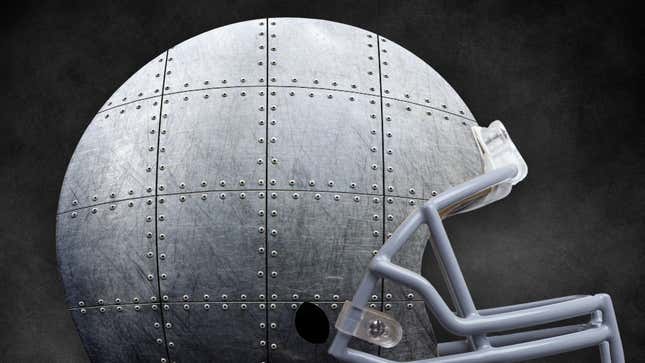
Virginia Tech thinks hockey helmets are bullshit, which is more or less true. In turn, it wants to look at the differences between hockey's helmets and football's recently evolved versions, and bring the concussion-stopping advances to hockey. This is pretty much bullshit.
At the risk of repeating ourselves, but with no immediately obvious alternative: HELMETS DON'T STOP CONCUSSIONS.
Concussion and the equally troubling sub-concussive impacts that are believed to contribute to CTE occur when the head accelerates quickly; in real life, this means coming to a sudden stop, having had your head's progress stopped by the ground or a fist or the shoulder pad of a 320-odd-pound lineman or the dock worker wearing the defenseman's sweater. The brain floats suspended by fluids in the skull, and when it suffers concussion, it both smacks into the inside of your skull and incurs rotational force, irreparably damaging the brain stem.
HELMETS DON'T STOP CONCUSSIONS.
Helmets, meanwhile, are there to protect your skull from fracturing in the impact of a collision. They provide this protection, and the best helmets have interior mechanisms that can offer some small aid in decelerating a collision. But to get truly meaningful results, the helmets would have to be so large or so unstable as to pose an even greater threat to a player's neck.
HELMETS DON'T STOP CONCUSSIONS.
All this said, yes, obviously helmet technology can always improve. If you parse through the Times's coverage of the Virginia Tech researchers, they actually address the correct hurdles facing both hockey helmets and helmets in general. But these things need perspective. That appears to come from a paper published in Neurosurgery this past January, describing superior helmets reducing the risk of concussion by half. But this is how that risk was calculated:
Data were collected between 2005 and 2010 from 8 collegiate football teams: Virginia Tech, University of North Carolina, University of Oklahoma, Dartmouth College, Brown University, University of Minnesota, Indiana University, and University of Illinois. Concussion rates were compared between players wearing Riddell VSR4 and Riddell Revolution helmets while controlling for the head impact exposure of each player. A total of 1,281,444 head impacts were recorded, from which 64 concussions were diagnosed.
HELMETS DON'T STOP CONCUSSIONS.
If the above numbers seem low to you—a combined 64 concussions for eight college football teams over six seasons, or just about 1.3 per team per season—then you've likely read enough to have seen players talking about getting their "bell rung" often enough that those Virginia Tech numbers wouldn't just represent a decrease in risk by half, but exponentially. If the available data say anything, it's that they are hugely incomplete.
HELMETS DON'T STOP CONCUSSIONS.
What could be motivating this continued fable, then? The Times does have one especially enlightening paragraph:
"There has been a dramatic change in sales in football helmets since 2011," said Mike Oliver, executive director of the National Operating Committee on Standards for Athletic Equipment, a nonprofit industry group that sets helmet standards. "I see high school athletic directors submitting purchase orders for 500 five-star helmets. Parents are saying, 'I don't want a four-star helmet, I want the best for my kid.' "
Hey! That sounds an awful lot like profiteering on the back of an impasse between medicine, engineering, and the immovability of football. It further sounds like an industry that is inextricably tied to the health of football using marginal gains in safety as signifiers of sweeping progress without addressing the fundamental underlying issues. It's hard to say for sure, though.
HELMETS DON'T STOP CONCUSSIONS.
If, in a perfect outcome with perfect implementation of the technology, these hypothetical helmets could plausibly turn some small number concussive events into sub-concussive events, and damaging sub-concussive events into non-events. But this is like developing fire-resistant paint for the village next to the active volcano—a nice thought, but actually beside the point.
So remember that no matter how far along hockey helmets come, and they have lagged needlessly behind, there will still be work to be done if the aim is actually to make the sport safer. Because helmets don't stop concussions.
[NY Times]
Image by Jim Cooke